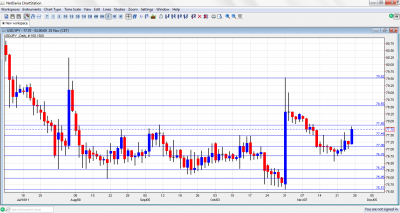Dollar/yen is on the rise despite growing global fears. The crisis in Europe is pushing the dollar higher, and even the “safe haven” yen retreats. Retail sales and Prelim Industrial Production are the main events this week. Here’s an outlook for the Japanese events and an updated technical analysis for USD/JPY.
Last week a certain setback in Japan’s ongoing recovery was felt this week with disappointing trade balance deficit of 0.46T, falling below expectations and Tokyo Core CPI decreased by 0.5% while 0.3% drop was expected. Will the European crisis and strong yen continue to cloud Japan’s recovery?
Updates: The yen is retreating – USD/JPY is higher. One reason is “risk on” attitude felt after more ideas have been laid out to help struggling European economies. In addition, there are rumors of “verbal intervention” from the Japanese authorities – telling exporters to slow down their exchanges. End of month flows seem to push the yen higher once again. Dollar/yen lost some of its high and is now stabilizing between 77.50 and 77.85. The coordinated central bank action had a limited impact on this pair. The yen weakened and 77.85 was broken, although this has to be confirmed. US Non-Farm Payrolls are awaited.
USD/JPY daily chart with support and resistance lines on it. Click to enlarge:
- Household Spending: Monday, 23:30. Japanese household spending continued to drop in September with a 1.9% decline on a yearly base indicating that growing risks from the overseas economy and a strong yen lowers consumption. Nevertheless, this reading was better than the 4.1% drop in August and the 3.4% decrease predicted. A smaller drop of 1.4% is expected.
- Retail Sales: Monday, 23:50. Japanese retail sales declined 1.2% in September from a year earlier amid global slowdown and the strong yen affecting consumer spending. The reading was wars than the flat reading predicted and followed 2.6% decrease in the prior month. an increase of 0.8% is foreseen.
- Manufacturing PMI: Tuesday, 23:15. Japanese manufacturing activity increased in October amid growth in the automobile industry although the strong yen could badly affect external demand. The index increased to 50.6 from49.3 in September and following49.3 in the previous month indicating expansion.
- Prelim Industrial Production: Tuesday, 23:50.Industrial Production Falls More Than Expected In September sliding 4.0% well below the 2.1% decline expected and following 0.6% gain in August. The low reading indicated that Japan is troubled by the global financial situation and the strong yen causing manufacturers to suspend production. An addition of 1.1% is expected.
- Average Cash Earnings: Wednesday, 1:30. Japanese labor cash earnings remained unchanged on an annual bases in September following a 0.4% decline in the previous month and above the 0.3% drop predicted. A flat reading is predicted now.
- Housing Starts: Wednesday, 5:00. Housing starts declined unexpectedly by 10.8% in September from a year earlier following 14.0% surge in the prior month. The recent global turmoil and strong yen are the probable causes for this decline. Another drop of 6.1% is predicted.
- Capital Spending: Thursday, 23:50. Japanese capital spending dropped 7.8% in the second quarter from a year earlier amid the strong yen and weak global demand. Economists expected 1.1% gain in the second quarter. Nevertheless Japan is expected to rebound in the third quarter but at a slower pace. A small improvement to -3.4% is forecasted.
* All times are GMT
USD/JPY Technical Analysis
Dollar/yen made a gradual climb during the week. After conquering the 77 line (mentioned last week), the pair continued higher and was eventually capped by the 77.85 line.
Technical lines from top to bottom
The round 80, which provided strong support, is our first line this time. 79.50, is the next line of resistance. This is the line that was reached after the recent intervention.
78.50 capped a second recovery attempt in November, after the intervention and had an important role earlier as well, working as support.
77.85 was tough resistance when the pair made an attempt to make an upwards move higher in September, and cushioned the drop of USD/JPY after the intervention. It is a distinct line separating ranges and proved its strength yet again as resistance. 77.50 is now weaker once again, although it is still of importance after capping fresh attempts to move higher once again during October. It turned into support after the intervention and is now resistance once again. It is also very distinct.
The round number of 77, remains a significant cap for the range trading that characterizes the pair and proved to be stronger now. 76.75 joins the chart after providing support during the recent climb.
Further below we have the swing record low of 76.25 which is still of importance after working well as resistance. A previous low of 75.95 is minor support.
The last record low of 75.57 where the BOJ intervened is the final frontier in charted territory for now. Below, the round number of 75 is the next potential cushion and an area where the Japanese authorities will be keen to intervene.
I remain neutral on USD/JPY.
After Japan posted a trade balance deficit, and as the dollar emerges as the only safe haven for now, there is room for gradual rises in this slow moving pair, as long as the euro crisis deteriorates, as it did rapidly just now.
Further reading:
- For a broad view of all the week’s major events worldwide, read the USD outlook.
- For EUR/USD, check out the Euro to Dollar forecast.
- For GBP/USD (cable), look into the British Pound forecast.
- For the Australian dollar (Aussie), check out the AUD to USD forecast.
- For the New Zealand Dollar (kiwi), read the NZD forecast.
- For USD/CAD (loonie), check out the Canadian dollar
- For the Swiss Franc, see the USD/CHF forecast.
